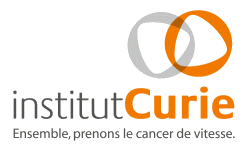
The web supplement to
Monica Arnedos et al. 2014



|
|


|
| REMAGUS04 trial |
| Monica Arnedos1,2, Marie-Eglantine Dujaric3, Florence Lerebours4, Samar Alsafadi1,2, David Gentien5, Suzette Delaloge1, Philippe Vielh6, Audrey Rapinat4, Emmanuel Barillot7, Fabien Valet3, Etienne Brain4, Brigitte Sigal-Zafrani8, Nicolas Servant7, Fabrice André1,2,9, Jean-Yves Pierga10,11 |
|
1Gustave Roussy, Department of Medical Oncology, Villejuif F-94805, France 2CGustave Roussy, INSERM Unit U981, Villejuif F-94805, France 3Institut Curie, Department of Biostatistics, Paris France 4Institut Curie, Department of Medical Oncology, St Cloud, France 5 Institut Curie, Department of Translational Research, Paris France 6Gustave Roussy, Department of Pathology, Villejuif F-94805, France 7Institut Curie, INSERM Unit U900, Paris France 8Institut Curie, Pathology Department, Paris France 9Université Paris Sud, le Kremlin Bicêtre, France 10Institut Curie, Department of Medical Oncology, Paris France 11Université Paris Descartes, France |
|
Abstract Purpose: We evaluated whether whole genome array approach is feasible in daily practice, and if the use of a genomic score (DLD30/TOP2A) improves chemotherapy efficacy. Methods: REMAUS04 is a phase III trial comparing DNA array-based chemotherapy (by DLD30 score and TOP2A expression) to standard neoadjuvant chemotherapy, in patients with HER2-negative breast carcinoma not eligible for conserving surgery. DNA arrays were performed within 15 days after tumor biopsy. Only samples with >30% cancer cells, a RIN>6 and good cDNA quality were eligible for hybridization on arrays U133Av2. The trial, designed to include 300 patients was stopped after a preplanned interim analysis showing <3 pathological Complete Response (pCR) in patients with DLD30-negative/TOP2A-negative tumor. Results: DNA array was feasible within 15 days in 205 out of the 303 patients in the screening phase (68%) and 142 patients were randomized in the treatment phase. Microarray accurately quantified gene expression (r=0.80 correlation with IHC for ER expression). No difference of treatment efficacy was observed between genomic and standard arm (pCR rates: 22% and 21% respectively). DLD30+ score was associated with an increased likelihood of pCR (36% versus 3% for DLD30-, multivariate analysis: OR=4.7, 95%CI: 0.87–35.9, p=0.09). Unplanned retrospective analyses showed that immune signatures were associated with a higher likelihood of pCR. Conclusion: This prospective trial suggests that implementing whole genome array in daily practice is feasible, but is facing the issue of low cellularity samples to be fully implemented. The current study suggests that DLD30 gene score and immune signatures could identify chemosensitive patients. Key words: breast cancer, chemotherapy, gene expression arrays, randomized trial. . |
| Download data: | ||
| Raw data file | Get them (.gz) | |
| Raw data Normalized(.xlsx) | Get it |
| Last modified November 04 2014 12:23:31 |